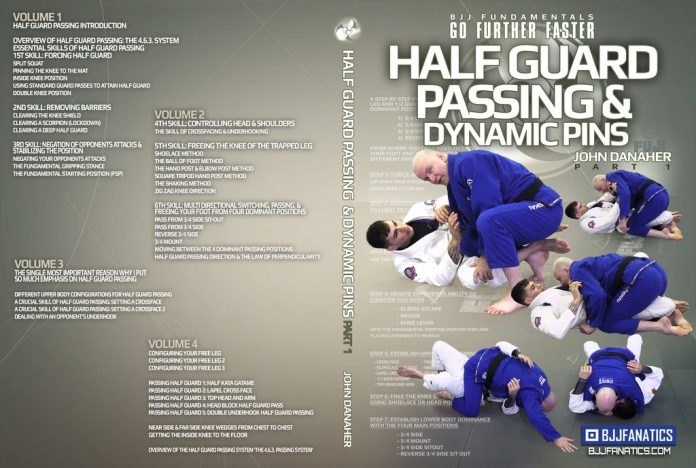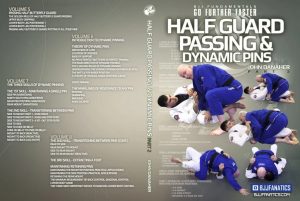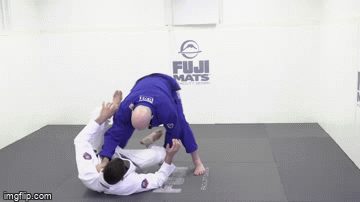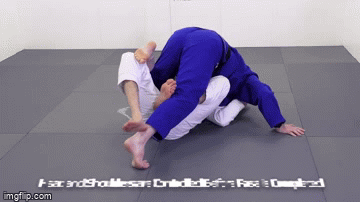
The man with the plan in BJJ is back with his god knows which DVD. While we’ve most definitely stopped counting all the John Danaher instructional DVDs, we by al lemans pay attention to them. And in particular, the latest couple of BJJ DVDs by the Jiu-Jitsu guru seem very interesting. They refer to top positions, after a bunch of instructional dealing with guards and bottom positions. After his take on passing the guard, Danaher now issued a very unique DVD. It is all about half guard passing, which he liked to focus on definitely form general guard passing (explained later) and dynamic pins. This second portion is something nobody has ever covered before. Trust me, I’ve looked everywhere.
ON SALE HERE:
John Danaher – Passing and Dynamic Pins

Owning a John Danaher instructional is not a matter of “if” anymore, but of “which”. Let’s be honest, there are too many to be able to take in all the knowledge John is providing. However, most of use have been stacking them up, mostly depending on whether it is Gi or No-GI we’re focusing on. His latest escapade is yet another part of the Gi BJJ Fundamentals series dubbed Go Further Faster. As we know, John likes to teach people how to become extremely good in the shortest time possible. Once again, his DVD contains incredible information and details, this time on the much-needed subjects of Dynamic Pins and Half Guard passing.
Exploring Top Positions with John Danaher
Maintaining a top position in any grappling martial art is the ultimate goal of grapplers. When you come to think about it, no bottom position really score you points. Apart from submitting someone off your back, the only way to start scoring is sweep, which is actually a way to get on top. From there on, top positions earn you the points to win a match. That indicates just how powerful they are and how much you can control someone.
Chirs Haueter likes to emphasize that you should always aim to be on top and stay on top. While getting in a top position will eventually happen in BJJ, staying in one is much more difficult. When that top position is still allowing the bottom person to maintain a defensive line of sorts then you most likely still haven’t passed their guard. And the half guard is the final frontier before starting to earn from dominant top positions in Jiu-Jitsu.
Half guard passing is probably the most difficult, given the position and the fact that there’s no other guard play left for the bottom person. This is one of the reasons there’s an entire John Danaher instructional focusing on this aspect of BJJ. Well, not an entire one, given that Danaher also makes the perfect confection between passing and exploring the nature of dynamic pins in Jiu-Jitsu.
The Dynamic Side Of BJJ Control
Pinning someone has always been something of an art, especially in BJJ. There’s nobody that really tried explaining it in an instructional. In fact, it was extremely difficult for me to find someone to really explain it live for me as well, despite having asked a myriad of black belts in seminars, camps, etc. So, I resorted to wrestling instructionals instead.
However, pining in wrestling, and most other grappling martial arts for that matter is very different to Jiu-Jitsu. Sure, you can learn the essentials from wrestling, but then you have to expand based upon them. It took me a lot of trial and error to figure out that pins in Jiu-Jitsu have nothing to do with keeping someone actually pinned. Instead, dynamic pins are all about control, and more importantly, restricting an opponent’s movement options, so they have to move in the direction of your choosing. Simply keeping someone on the ground will get you penalized in a BJJ match, rather than earing you a win like in wrestling or Judo. This is why the dynamic nature of pins in BJ is unique, and why I’m over the moon that there’s now a John Danaher instructional exploring this “mysterious” aspect of Brazilian Jiu-Jitsu.
Half Guard Passing and Dynamic Pins BJJ Fundamentals Go Further Faster John Danaher Instructional Full Review
It would be redundant at this point to talk about what we can expect from a John Danaher Instructional DVD. There’s hardly anyone among us that has not seen at least parts of one and remained in awe. Well, seeing a Danaher instructional is no longer such a rarity. In fact, there’s arguably too many of them. Still, some really hit the spot, and this latest Go Further Faster volume covering Half Guard Passing and Dynamic Pins is exactly one such DVD.
In this DVD, you get 8 volumes, 5 of which are all about the half guard. Why so much focus on passing the half guard? You’ll get answers in a dedicated volume about that. The remaining three volumes cover dynamic pining. The organization of the material is of course, in a progression, but centers around essential skills you need to master both the passing and pinning aspects. That really makes it easy to follow, remember, and put to use on the mats. Without further ado, let’s get into the play-by-play review of this BJJ DVD.
#1. Half Guard Passing: The Skills
Of course, there’s a “short” introduction to half guard passing as a whole to kick things off. That short introduction will explain all about the system Danaher uses to pas half guard, a system he named the 4.6.3 system. And it is all about mastering 6 essential skills of passing.
The first volume of this Danaher Instructional is all about the first three skills. It starts with forcing half guard, which is something you might already be doing. Some known aspects of the Danaher passing system, like the split squat position and the inside knee position, make an appearance again.
The second skill John covers is about removing barriers, or the “dreaded” frames bottom grapplers use to create and retain space. In other words, things like the knee shield, lockdown, and even deep half won’t present problems ever again.
Finally, the third essential skill of the half guard passing system covered in this volume is about negating resistance and saying in the position you’ve gained. Some key insights into gripping stance and what Danaher calls the fundamental starting position are in the focus here.
#2. Even More Passing Skills
The second volume of the Half Guard Passing and Dynamic Pins Danaher DVD continues where the first stopped. There are three more skills to Danaher’s 4.6.3 system, with the 4th being head and shoulder control. Not unknown, but definitely p[resented form a different perspective to the one we usually have of crossfacing.
The fifth and penultimate skill is something John spends quite a lot of time on – freeing your knee. This is where most of the half guard battle takes place anyway. There are 6 different methods to help you develop this skill and they all tie in together creating dilemmas and trilemmas for the bottom person.
The final skill is about actually getting past the legs. It involves switching directions and completely freeing your foot from any remainders of the half guard, like the 1/4 guard and the ¾ mount. Plus, John shares the four dominant passing positions and how to move between them.
#3. Why Focus On Half Guard Passing?
Finally, an answer to the question most of us had from the start – why a dedicated John Danaher instructional DVD on passing half guard? Well, the single most important thing according to John is revealed here. Moreover, he also goes on to explore subjects like upper body configurations, as well as going really deep into the mechanics of the crossface. If you thought the crossface couldn’t get any more brutal, let me tell you right now, you were wrong.
Wrapping up this portion of the instructional is the all-important chapter on dealing with the bottom person’s underhook.
#4. Passing Variations

The first portion of the volume is all about lower body configuration, to go hand in hand with the upper body already covered earlier. The bulk of the volume covers actual passing sequences and variations, based on the 6 essential skills of the system. There are 5 different passes: the Kata Gatame, lapel crossface, top head and arm, head block, and double underhook. All of them are covered in incredible depth.
Also in this volume, you’ll find useful information on knee wedges, getting the knee to the floor, and a general overview of the entire 4.6.3 system as a whole.
#5. Dealing With The Half Butterfly
The half butterfly guard get s a volume of its own outside the system because it is arguably, the most dangerous half guard variation you can come up against. Danaher starts with the golden rule of butterfly half guard passing, before exploring more specific things, like upper body grips and lower body positioning. It is all about weight distribution and shifting here. John puts it all together beautifully at the end to provide you with a foolproof method of beating the butterfly half guard. Which gets us to the dynamic pins.
#6. Introduction To The Theory Of Dynamic Pins
Similarly o the half guard portion, Danaher starts off discussing the general theory of dynamic pins in BJJ. The subject is not an easy one, so there’s a lot of talk, and a lot of points to take away. However, this Danaher instructional is definitely the first to really try and put things into perspective for grapplers of all levels.
He starts off by defining pins and talking a lot about wedges, which comes as no surprise, really. Chapters on the base of support, the main goal of pinning as well as 3 golden rules of dynamic pins follow suit. I particularly enjoyed the portion on scoring criteria in BJJ and how pins relate to them.
The portion on static pinning, that’s just put in there on its own might just be the one most important chapter in this entire John Danaher instructional. Just saying.
Wrapping up is a portion on lines of resistance to pins and how to deal with stuff like shrimping, bridging, and pushing.
#7. Essential Pinning Skills
Similarly to half guard passing, Danaher’s dynamic pins system is based on essential skills. Unlike passing, though, there are fewer skills here. In fact, her are just three, to be exact. The first one is all about maintenance, or staying in a pin position for as long as you want to. The pins covered are the side pin, North-South, mount, and back.
The second skill obviously very important,. Given that it starts in this volume, and extends well into the next one. It has to do with transitioning between pins while not letting an opponent escape. That is what dynamic pins are all about, in essence. This volume wraps up with several different ways of progressing from side control to mount, and then form mount to the back.
#8. Maintaining Pins
The final volume of the Half Guard passing And Dynamic Pins John Danaher Instructional DVD covers the few remaining pin transitions to start with. Those are getting from the back into side control and then mount, as well as connecting side control and the back.

As a wrap-up, there’s a section that focuses on pin retention, or in other words, staying in position indefinitely. Once again, it is all about the mount, side control, and back mount, with key details on how to never get shaken off. Back control gets special attention, as you’d expect from a John Danaher instructional.
In Summary
Passing half guard is not an easy task, but this John Danaher instructional DVD will certainly make it easier. For me, though, the real value of this DVD is in the final three volumes, the ones focusing on dynamic pins for Jiu-Jitsu. There’s a lot of information in here to process, but it is the one Go Further Faster series DVD that I’ll stick with for the time being.
ON SALE HERE:
John Danaher – Passing and Dynamic Pins



![Darce Choke Encyclopedia – Origins, Mechanics and Variations [2025] BJJ, choke, Brabo, BJJ Darce Choke, D'arce Choke, Darce BJJ Choke](https://bjj-world.com/wp-content/uploads/2017/11/JungPoirierLeeYahoo-218x150.jpg)









![X-Guard Trickery Kyle Sleeman DVD Review [2025] X-Guard Trickery Kyle Sleeman DVD Review](https://bjj-world.com/wp-content/uploads/2025/03/x-guard-trickery-kyle-sleeman-dvd-review-218x150.png)
![Countering with Crab Ride Anthony Budion DVD Review [2025] Countering with Crab Ride Anthony Budion DVD Review](https://bjj-world.com/wp-content/uploads/2025/03/countering-with-crab-ride-anthony-budion-dvd-review-218x150.png)
![Closet Closed Guard Craig Jones DVD Review [2025] Closet Closed Guard Craig Jones DVD Review](https://bjj-world.com/wp-content/uploads/2025/03/closet-closed-guard-craig-jones-dvd-review-218x150.png)
![Xanadu Back Takes Levi Jones-Leary DVD Review [2025] Xanadu Back Takes Levi Jones-Leary DVD Review](https://bjj-world.com/wp-content/uploads/2025/03/xanadu-back-takes-levi-jones-leary-dvd-review-218x150.png)

![No-Gi Grapplers Guide To Front Headlock Joel Bane DVD Review [2025] No-Gi Grapplers Guide To Front Headlock Joel Bane DVD Review](https://bjj-world.com/wp-content/uploads/2025/03/no-gi-front-headlock-joel-bane-dvd-review-218x150.png)
![I Got Your Back Jake Straus DVD Review [2025] I Got Your Back Jake Straus DVD Review](https://bjj-world.com/wp-content/uploads/2025/03/i-got-your-back-jake-straus-dvd-review-324x235.png)
![Master Scissor Sweep Ryan Scialoia DVD Review [2025] Master Scissor Sweep Ryan Scialoia DVD Review](https://bjj-world.com/wp-content/uploads/2024/12/scissor-sweep-ryan-scialoia-dvd-review-100x70.png)

![Edging Yourself Out Of Danger Craig Jones DVD Review [2024] Edging Yourself Out Of Danger Craig Jones DVD Review](https://bjj-world.com/wp-content/uploads/2024/12/edging-yourself-out-of-danger-craig-jones-dvd-review-100x70.png)
![Osoto Gari for Jiu Jitsu Jackson Nagai DVD Review [2024] Osoto Gari for Jiu Jitsu Jackson Nagai DVD Review](https://bjj-world.com/wp-content/uploads/2024/10/osoto-gari-for-jiu-jitsu-jackson-nagai-dvd-review-100x70.png)



![Tricks for Unstoppable Takedowns Georges St Pierre DVD Review [2024] Tricks for Unstoppable Takedowns Georges St Pierre DVD Review](https://bjj-world.com/wp-content/uploads/2024/12/unstoppable-takedowns-georges-st-pierre-dvd-review-100x70.png)
![Old School BJJ Ricardo Cavalcanti Fundamentals DVD Review [2024] Old School BJJ Ricardo Cavalcanti Fundamentals DVD Review](https://bjj-world.com/wp-content/uploads/2024/09/old-school-bjj-ricardo-cavalcanti-dvd-preview-100x70.png)


![Two Sides One Game Sweep and Pass Marcos Tinoco DVD Review [2024] Two Sides One Game Sweep and Pass Marcos Tinoco DVD Review](https://bjj-world.com/wp-content/uploads/2024/11/sweep-and-pass-marcos-tinoco-dvd-review-100x70.png)



![Modern Split Squat Passing Jason Rau DVD Review [2024] Modern Split Squat Passing Jason Rau DVD Review](https://bjj-world.com/wp-content/uploads/2024/11/modern-split-squat-passing-jason-rau-dvd-review-100x70.png)


![Roger Gracie Guard Passing System DVD Review [2025] Roger Gracie Guard Passing System DVD Review](https://bjj-world.com/wp-content/uploads/2025/02/roger-gracie-guard-passing-system-dvd-review-100x70.png)

![Complete Front Headlock System Michael Pixley DVD Review [2024] Complete Front Headlock System Michael Pixley DVD Review](https://bjj-world.com/wp-content/uploads/2024/10/front-headlock-system-michael-pixley-dvd-review-100x70.png)
![The Whole Omoplata Enchilada Lyanne Perez DVD Review [2024] The Whole Omoplata Enchilada Lyanne Perez DVD Review](https://bjj-world.com/wp-content/uploads/2024/11/whole-omoplata-enchilada-lyanne-perez-dvd-review-100x70.png)


![Reverse Arm Bar System Andrew Kerfoot DVD Review [2024] Reverse Arm Bar System Andrew Kerfoot DVD Review](https://bjj-world.com/wp-content/uploads/2024/10/reverse-arm-bar-system-andrew-kerfoot-dvd-review-100x70.png)

![Woj Lock the World Chris Wojcik Ankle Locks DVD Review [2024] Woj Lock the World Chris Wojcik Ankle Locks DVD Review](https://bjj-world.com/wp-content/uploads/2024/12/woj-lock-the-world-chris-wojcik-dvd-review-100x70.png)